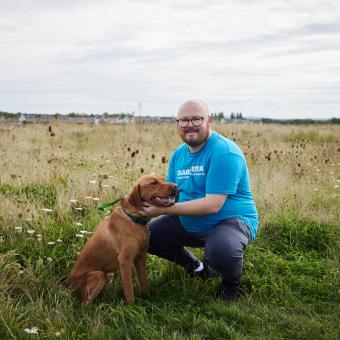
Diabetes was once the leading cause of sight loss among working-age people in the UK. Thanks to research we funded, it isn’t any more.
Professor Roy Taylor was shocked by the level of sight loss in people with diabetes in Newcastle – especially in young people. So, with our funding, he pioneered the use of a new type of retinal camera.
Detecting diabetic retinopathy
Set up in the back of a second-hand ambulance, he visited diabetes clinics around Newcastle to detect sight-threatening diabetic eye disease, known as retinopathy. He hoped catching this early could prevent sight loss.
It proved more practical and effective than existing screening methods. So, we helped him expand his fleet of mobile screening units across the UK to show it worked on a bigger scale.
Professor Roy Taylor, Newcastle University, said:
“When I was appointed consultant in 1985, I was caring for two women under the age of 21 who were blind due to diabetes. There were four other young people in our clinic similarly affected.
“Something had to be done to help us catch and treat retinopathy early. With the support of Diabetes UK, easier, more effective screening methods allowed us to do just that and prevent loss of sight.
“We subsequently showed that in the following 16 years no-one under the age of 35 lost their sight due to diabetes in the Newcastle District. We’re now seeing the impact of this work on the lives of people with diabetes across the world.”
His success led us to campaign for a national eye screening programme for people with diabetes which was rolled out in 2002.
Now the five million people currently living with diabetes in the UK all have access to eye screening.
James Baille, who lives with type 1 diabetes, said:
“Eye screening has benefited me greatly and prevented me from losing my eyesight. Because problems were spotted early, I was able to get treatment to deal with them before there was any lasting damage.
“The monitoring and attention we get from eye screening is giving me the confidence in retaining my eyesight.”

What's next?
Our researchers are working tirelessly to make sight loss a diabetes complication of the past.
Take Dr Paul Neditru, who has been exploring how artificial intelligence can be used to predict who is at high risk of retinopathy and how quickly it will get worse, so people can get the right care earlier on.
But improved screening can only take us so far, and there’s still an urgent need for treatments to prevent or reverse the damage.
That’s why we’re funding scientists – like Dr Judith Lecher – to test cutting-edge new ideas in the lab. She’s investigating if a protein can be used to repair and protect damaged cells in the eye, to slow the progress of retinopathy in its earliest stages.
